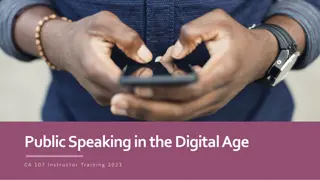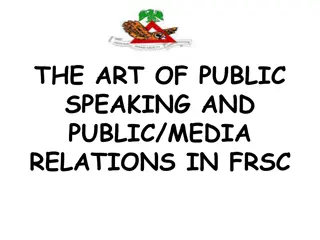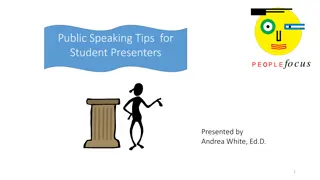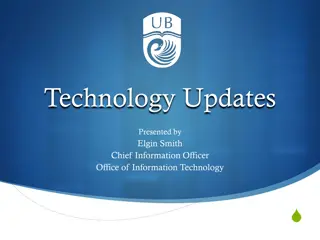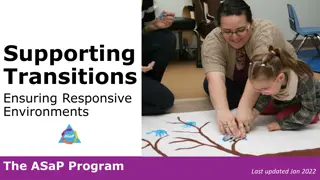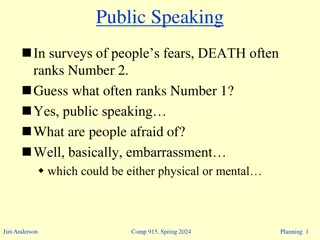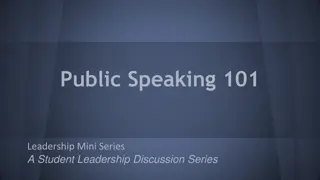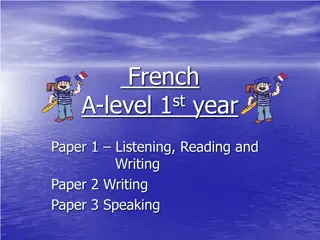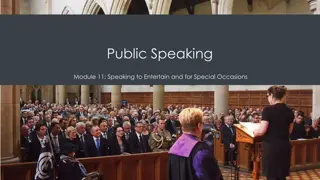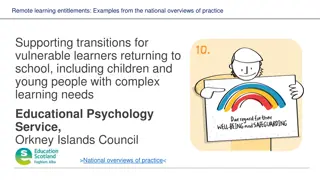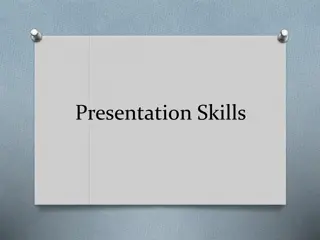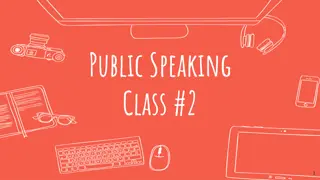Effective Techniques for Using Transitions in Public Speaking
Learn how to effectively use transitions in public speaking to connect ideas, enhance understanding, and maintain audience engagement. Discover the importance of verbal bridges between ideas and how to smoothly transition between main points and subpoints in your speech. Explore techniques for creating impactful transitions, such as restating and forecasting key points. Elevate your communication skills and captivate your audience with seamless transitions in your presentations.
Download Presentation

Please find below an Image/Link to download the presentation.
The content on the website is provided AS IS for your information and personal use only. It may not be sold, licensed, or shared on other websites without obtaining consent from the author.If you encounter any issues during the download, it is possible that the publisher has removed the file from their server.
You are allowed to download the files provided on this website for personal or commercial use, subject to the condition that they are used lawfully. All files are the property of their respective owners.
The content on the website is provided AS IS for your information and personal use only. It may not be sold, licensed, or shared on other websites without obtaining consent from the author.
E N D
Presentation Transcript
Communicating technology Guiding your audience: metalanguage LC-1114 Communicating technology
TRANSITIONS Verbally and logically connect ideas, facts and the elements of the talk. Why? To make what you are saying easier to understand.
TRANSITIONS are words, phrases, or sentences that connect the speech ideas together are verbal bridges between ideas alert the audience that a new point will be made Let s now In conclusion, To sum up, However, Another reason is I d now like to
TRANSITIONS ARE USED after the introduction between each main point within each main point between slides before the conclusion
TRANSITIONS Transitions between main points When moving from one main point to another, full- sentence transitions are especially effective Next, let's look at exactly what sales contests can do for us.
TRANSITIONS Transitions between subpoints 1. Adjectives, like another and other 2. enumeration, such as First, Second, third, 3. superordinate terms in guiding your audience between points. Another way that sales competitions will benefit us is by their relative cost effectiveness.
TRANSITIONS Transitions between subpoints 1. Adjectives, like another and other 2. enumeration, such as First, Second, third, 3. superordinate terms in guiding your audience between points. A second reason why sales competitions will benefit us is their relative cost effectiveness.
Superordinate terms NUMBER + [superordinate] + [list of items] Today's computer-display manufacturers are limited by threefactors. The first factoris Anotherfactoris . And the thirdfactoris [superordinate] + SUCH AS / INCLUDING + [examples] The mobile lifestyle we know today would not be possible without vehicles such asautomobiles, buses, trams, and aircraft.
Techniques for creating transitions 1. Restate-forecast Restates the point just covered and previews the point to be covered next Now that we've established a need for sales contests (restatement), (restatement),let's now take a look at what sales contests can do for us (forecast) (forecast). Now that we've established a need for sales contests Now that I've shown you that "junk" is the appropriate word to describe junk bonds, to describe junk bonds, we will turn to an analysis of three secure financial instruments: bank certificates of deposit, Treasury bonds, and high quality corporate paper. Now that I've shown you that "junk" is the appropriate word
Techniques for creating transitions 2. Rhetorical questions Rhetorical questions are effective, because the audience wants to see if you agree with their answer. Will contests be too expensive? Well, actually they won t because... How do the costs of contests stack up against the expense of training new people? Well, if you take a look at the following graph
Techniques for creating transitions 3. Internal previews Internal previews are frequently used in the body of the speech to outline in advance the details of a main point. Now, I d like to talk about the orientation you can expect to receive during your first few days on the job including a tour of the plant, a one-on-one meeting with your supervisor, and a second meeting with the personnel director, who will explain the benefits and responsibilities of working for our corporation.
Techniques for creating transitions 4. Internal summaries Internal summaries draw together important ideas before proceeding to another speech point. They help remind listeners where they have been. It should be clear now that the kind of violence we've witnessed in the schools and in our communities has a deeper root cause than the availability of handguns. Our young children are crying out for a sense of community, of relatedness and meaning, that they just aren't finding in the institutions that are meant to serve them.
In sum, Use transitions to move from intro to the first main point between main points between subpoints between slides from last main point to the conclusion Use a variety of techniques to create transitions Restate-forecast Internal previews Internal summaries Rhetorical questions Superordinate terms
Assignment 5: Outline Add the transitions to the places indicated in the outline template. - use the outline template - check also the example outline A5 should include: - General info (first section) - Introduction (in full language) - Transitions - Main points (as headings + possible subpoints) - Conclusion (in full, as you would speak it) SUBMIT TO MYCOURSES!




